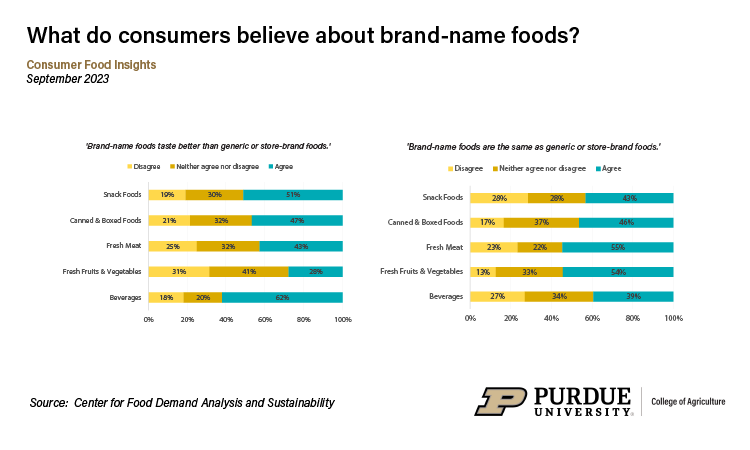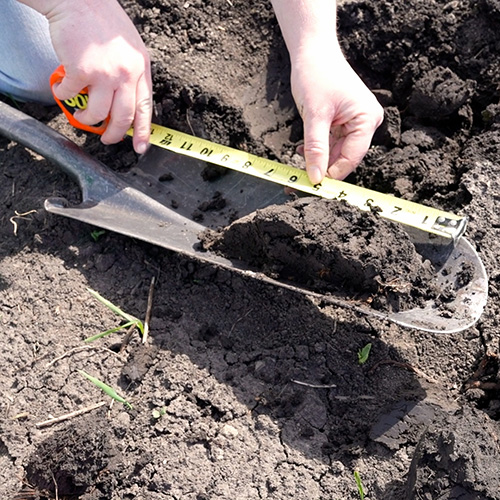Most consumers would choose brand-name beverages over generic or store-brand beverages, according to the September 2023 Consumer Food Insights Report. The report further indicates that consumers make this choice even when presented with a sizable price discount on generic or store brand names.
The survey-based report out of Purdue University’s Center for Food Demand Analysis and Sustainability assesses food spending, consumer satisfaction and values, support of agricultural and food policies, and trust in information sources. Purdue experts conducted and evaluated the survey, which included 1,200 consumers across the U.S.
In contrast to beverage choices, most survey respondents said they were unwilling to pay a premium for brand-name meat or fruits and vegetables. The findings in the report’s “Brand Beliefs” section were based on new questions that yielded some interesting results, said the report’s lead author Joseph Balagtas, professor of agricultural economics and director of CFDAS at Purdue.
 Brand beliefs by food category, September 2023
Brand beliefs by food category, September 2023 “When it comes to snack foods, consumer choice is price sensitive,” Balagtas said. “A majority of consumers tell us that brand-name products taste better. And even when generics are 15% cheaper, a majority choose the brand-name product. But if generics are 30% cheaper, a majority of consumers will choose the generic brand.”
To dig deeper into why consumers might or might not choose brand-name food, the survey included follow-up questions that gathered consumer beliefs about brand-name versus generic or store-brand foods.
“We find that taste is positively correlated with the decision to choose brand-name foods over cheaper substitutes,” Balagtas said. Consumers perceive brand-name beverages to taste better than generics and thus are more likely to purchase branded products even at a premium. But fewer consumers believe that brands are associated with better taste in the meat and fruit and vegetable aisles, and thus fewer are willing to pay a premium for those products.
“Across all food categories, most consumers do not believe that brand-name foods are more nutritious or made from better ingredients or safer than store brands,” Balagtas said. “Our finding that taste is the main driver of consumers’ valuation of brand names is consistent with results from our food values survey questions, where respondents consistently rank taste as the most important attribute when shopping for food.”
 Brand name vs. generic or store-brand choices by food category and price discount, September 2023
Brand name vs. generic or store-brand choices by food category and price discount, September 2023 Additional key results from the September report include:
- Households making less than $50,000 were more price sensitive when presented with two generic or store-brand discounts.
- The consumer food inflation estimate (6.3%) continues to diverge from the government consumer price index of food inflation (4.3%).
“We see that brand choices differ slightly when disaggregated by income,” said Elijah Bryant, a survey research analyst at the center and co-author of the report. “Those who make less than $50,000 are more responsive to changes in the price of their food options.”
While consumers with the lowest income already tend to choose generic brands over brand names, this disparity grows when the discount on generic or store-brand foods is doubled from 15% to 30%.
In the food expenditures category, Bryant noted a slight decrease in average food-away-from-home (FAFH) spending, which has gone down since June. “This could be a result of FAFH inflation cooling at a slower rate than food-at-home inflation, meaning a dollar goes further for consumers at the grocery store than it does at restaurants,” he said.
Total weekly food spending has increased by 1.6% since last September, which is below the government’s food inflation estimate of 4.3%. This suggests that consumers might either be buying slightly less food or more affordable food options relative to last year, Bryant said.
Food security remained under the 2022 average of 15% this month (13%), dropping slightly from last month (14%). “Consumers continue to be happy with their diets and lives as a whole, though lower-income households tend to be less happy with their diets and lives than those in higher-income households,” Bryant said.
The Center for Food Demand Analysis and Sustainability is part of Purdue’s Next Moves in agriculture and food systems and uses innovative data analysis shared through user-friendly platforms to improve the food system. In addition to the Consumer Food Insights Report, the center offers a portfolio of online dashboards.





